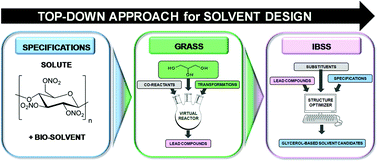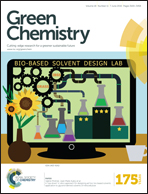A “top-down” in silico approach for designing ad hoc bio-based solvents: application to glycerol-derived solvents of nitrocellulose
Abstract
Potentially effective glycerol-based solvents for nitrocellulose have been designed using a top-down in silico procedure that combines Computer Assisted Organic Synthesis (CAOS) and Molecular Design (CAMD). Starting from a bio-based building block – glycerol – a large number of synthetically feasible chemical structures have been designed using the GRASS (GeneratoR of Agro-based Sustainable Solvents) program. GRASS applies well-selected industrial chemical transformations to glycerol together with a limited number of relevant co-reactants. Then, the most promising structures are considered as lead compounds for further modification in silico thanks to the IBSS (InBioSynSolv) program, which generates derivatives with alkyl, cycloalkyl, alkene, cycloalkene or phenyl substituents. Finally, IBSS ranks all the candidates according to the value of their overall performance function to best fit the predefined specifications, i.e. (i) high solubilisation of nitrocellulose, (ii) slow evaporation and non-flammability (iii) low toxicity and environmental impact. This general strategy enables the highlighting of the most relevant solvent candidate derived from any building block for a given application. To validate the approach, 15 commercially available solvents derived from glycerol were confronted with nitrocellulose and led to highlight diacetin as an effective and safe solvent.


 Please wait while we load your content...
Please wait while we load your content...